Abstract
Groundwater plays an important role in ecological environment protection in arid and semi-arid areas. Therefore, understanding the characteristics of hydrochemical evolution is of great significance for the sustainable use of groundwater in the area of the Tailan River Basin. The Tailan River Basin is located in an arid, ecologically sensitive area in western China. In this study, we collected 42 groups of representative water samples from the Tailan River Basin and analyzed the chemical distribution in the groundwater using mathematical statistics, Piper and Gibbs diagrams, ion ratio analysis, and hydrogeochemical simulation methods. We also discussed the water–rock interactions in the groundwater hydrochemical evolutionary process. The results were as follows: (1) The chemical types of groundwater changed from HCO3·SO4-Ca·Na to SO4·Cl-Na·Ca, Cl·SO4-Na, and Cl-Na, and the total dissolved solids content increased from less than 1 g/L to more than 40 g/L from the gravel plain to the fine soil plain. (2) The Gibbs diagram, the ion ratio analysis, and the saturation index showed that the groundwater chemical characteristics in the study area were mainly controlled by water–rock interactions, as well as evaporation and concentration. Along the runoff of groundwater, halite and gypsum were dissolved. Nevertheless, dolomite and calcite precipitated. The relationship between the chlor-alkali index and [(Na+ + K+)-Cl−] and [(Ca2+ + Mg2+)-(HCO3− + SO42−)] indicated that cation exchange also affects the chemical composition of groundwater in the area. (3) Through reverse hydrogeochemical simulation, the main water–rock effect of the groundwater runoff process revealed by qualitative analysis was quantitatively verified.
1. Introduction
The northern part of China has an arid and semi-arid climate in which surface water resources are scarce and intermittent, typically more in summer and less in winter. Groundwater is the main water source supporting agricultural, industrial, and ecological needs in northwest China [,]. In particular, Xinjiang Province is an important agricultural production base and an important ecological barrier area in northwest China [,,]. The Tailan River Basin is located in the Aksu region of Xinjiang, south of the Tianshan Mountains and northwest of Tarim Basin, deep in the hinterland of Eurasia []. In recent years, with the growth of population and agriculture, groundwater extraction has increased []. The regional “water-quality shortage” caused by geochemical processes [] has become increasingly prominent [], severely restricting local economic development. Few studies regarding the chemical characteristics and influencing factors of groundwater in this region have been reported. Therefore, it is of great significance to carry out research on groundwater chemistry to reveal the change process and hydrochemical evolution law of the water environment in the study area. Understanding the interrelation between local groundwater and the environment will provide a theoretical basis for rational development and utilization of local groundwater resources, protection, and improvement in the ecological environment.
The traditional methods of assessing groundwater chemistry cannot accurately quantify geochemical processes []. Methods such as multivariate statistical analysis and reverse hydrogeochemical modeling are often used to determine the evolution of groundwater chemical composition [,]. The combination of traditional groundwater chemistry research methods and groundwater chemical evolution simulation is one of the most widely studied methods of groundwater chemical evolution [,,]. Wu Qiong et al. used hydrochemical diagrams, descriptive statistics, ion ratio analysis, and saturation index methods to analyze the characteristics, distribution, and causes of groundwater chemistry in Alar City, Xinjiang []. Ding Qizhen analyzed the characteristics and influencing factors of groundwater chemistry in Barkol Basin, Xinjiang, by using multivariate statistical methods. The results showed that groundwater chemistry was determined by the evaporation and concentration of Na+, Ca2+, Mg2+, Cl−, SO42−, total hardness (TH), and total dissolved solids (TDSs), which are main load variables and are influenced by the leaching of HCO3− []. Li Lin analyzed the distribution characteristics of the chemical types of surface water and groundwater in the Tarim River by means of ionic ratios and the Piper diagram, as well as the stable isotope method, and discovered that the water–rock interaction in this area was determined by the dissolution or precipitation of minerals, oxidation–reduction, and cation exchange []. Remi et al. analyzed the characteristics of groundwater hydrochemical evolution by using mathematical statistics, Piper and Gibbs diagrams, ion ratio analysis, and mineral stability field maps, as well as reverse hydrogeochemical simulation, in the Aksu plain region of Xinjiang []. Multivariate statistical analysis of minor and trace elements in water samples shows that groundwater quality is mainly controlled by geological factors, followed by human influence [,].
In this study, hydrogeological surveys have been carried out in the Tailan River Basin. The regional hydrogeological characteristics have been basically identified. Unfortunately, there was a lack of in-depth understanding of the hydrochemical origin and hydrochemical evolution of groundwater, as well as water–rock interactions of different geomorphic units. This paper discusses the geochemical characteristics, hydrogeochemical simulation, and origin of groundwater from the gravel plain to the fine soil plain by means of mathematical statistics, ion ratio analysis, and saturation index to explain the hydrogeochemical process determined by the chemical evolution of groundwater in the Tailan River Basin.
2. Materials and Methods
2.1. Study Area
The Tailan River Basin is located in Wensu County, Aksu Prefecture, Xinjiang Province, with geographical coordinates between 80°21′44″ and 81°10′14″ E and 40°41′41″–42°15′13″ N, which contain a mountainous area and a plain area. The total area of the basin is 5800 km2, including the mountainous area of 1300 km2 and the plain area of 4500 km2 (Figure 1). This region is a typical continental climate with four distinct seasons, a large temperature difference between day and night, sufficient light, and dry air. The meteorological data of the study area show that the annual average temperature near the mountainous area is 7~9 °C, and in the plain oasis area the annual average temperature is about 10 °C. The annual precipitation in the mountainous area is between 500 mm and 700 mm, while it is only 62 mm in the plain area. The average annual evaporation is about 1800 mm.
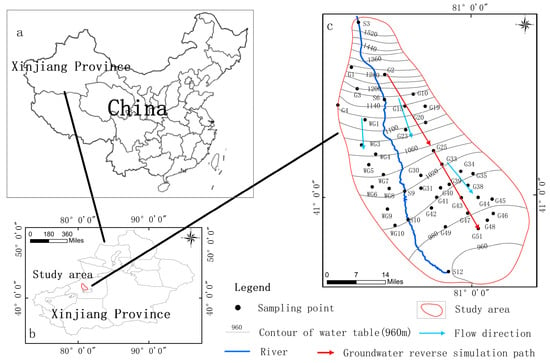
Figure 1.
(a,b)—location maps of the area; (c)—study area, sampling point distribution, and simulated route. Note: WG—west side groundwater; G—groundwater; and S—surface water.
The terrain in the northwest in the study area is higher than that in the southeast, and the geomorphic units in the Tailan River Basin are gravel plain, alluvial inclined plain, and fine soil plain (Figure 2).
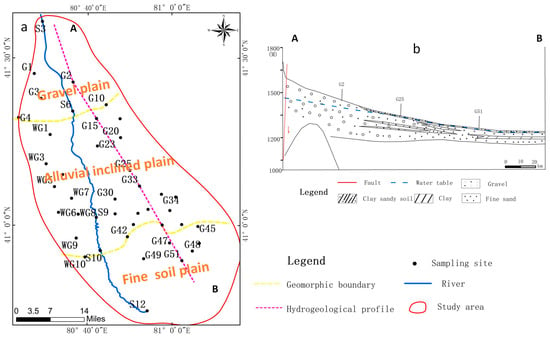
Figure 2.
(a)—geomorphic features; (b)—hydrogeological profiles.
2.2. Hydrogeology
The lithology changes from gravel to medium coarse sand, fine silt, and sandy soil. The surface water is mainly formed by the melting of snow and ice in mountains, atmospheric precipitation, and bedrock fissures. The river water seeps down into groundwater after passing mountains. The gravel plain area is a single aquifer structure. The lithology is sand gravel, and the groundwater depth is more than 50 m. The groundwater aquifer gradually extends from a single layer into a multi-layer structure, and the groundwater overflows to the surface in the middle and lower part of the inclined plain. Due to the continuous decline in the water table in recent decades, the overflow zone has disappeared. The fine soil plain is a multi-layer aquifer structure with flat terrain, slow groundwater runoff, and a groundwater depth usually less than 5 m. The direction of groundwater runoff on the west side of the Tailan River is north–south, and the direction of groundwater runoff on the east side of the river is located in the Awati Depression belt; the direction of groundwater runoff gradually changes from north–south to east–south [].
2.3. Sampling and Analysis
In order to understand the overall spatial changes in groundwater geochemistry in the study area, while avoiding the effects of peak summer meltwater on water chemistry, water samples were collected in the summer and autumn of 2022. The chemical composition of the dry season water is roughly close to the annual average for the region []. Hydrochemical samples were collected from different water bodies. Surface water comes from the river water of the Tailan River. Groundwater is mainly collected by hand drilling and local wells. There were 37 groups of groundwater and five groups of surface water. Professional measuring tools (RTKs) were used to determine the sampling location and elevation, and the depth of groundwater was measured using a water level meter.
To avoid other impurities remaining in the sample bottle, we washed the sample bottle three times with the water sample to be collected and filtered the water sample through a 0.45 μm filter membrane. Nitric acid was added to the cationic water sample and kept sealed until the pH of the water sample was less than 2. The collected samples were stored in an incubator at 4 °C, and all samples were analyzed by the second Hydrologic Engineering Geology Brigade within three weeks. Strict testing standards were adopted to ensure data quality, and the ion charge balance error of each sample was kept within ±5%. All parameters were determined in the laboratory according to the standard procedure (ref. [] test method for drinking natural mineral water). The physicochemical parameters measured include pH, HCO3−, SO42+, Cl−, NO3−, Mg2+, Ca2+, Na+, K+, total dissolved solids (TDSs), total hardness (TH), and total alkalinity (TA). K+ and Na+ were determined via flame atomic absorption spectrophotometry, and the detection lines were 0.05 mg/L and 0.01 mg/L, respectively. TH, Ca2+, Mg2+, CO32−, and HCO3− were determined using ethylenediamine tetraacetic acid disodium titration with a detection line of 1.0 mg/L. Cl− was determined via the silver nitrate volumetric method with a detection line of 1.0 mg/L; SO42− was determined via barium sulfate turbidimetry, and the detection line was 5.0 mg/L; and pH was determined via the glass electrode method, and the detection line was 0.01.
3. Results and Discussion
3.1. Water Chemical Characteristics
The descriptive statistics of the chemical components of each water sample are shown in Table 1. The pH value of the water samples in the study area ranges between 7 and 8.86, indicating that all water samples are weakly alkaline. The pH of the groundwater is mostly below 8.5. According to the WHO, the recommended maximum permissible limit for the pH of groundwater is 8.5. The pH values of the surface water and groundwater in the gravel plain are similar, ranging from 7.96 to 8.44, indicating that their sources are close.

Table 1.
The results of statistical analysis of hydrogeochemical composition of surface water and groundwater in the Tailan River Basin.
The alkaline intensity of groundwater is higher in the gravel plain than in the inclined plain, and it is higher in the inclined plain than in the fine soil plain. Only a few water samples in the study area had lower TH indices than normal, and the overall hardness of the water body was found to be higher than the WHO drinking water quality standards []. The NO3− content ranged from 0.8 to 57.8 mg/L, and only one sample at the end of the gravel plain had a NO3− content greater than 50 mg/L, which may be caused by local industrial and agricultural pollution. In general, the mass concentration of groundwater TDSs increased from 215 mg/L to 42,794 mg/L from the gravel plain to the fine soil plain, indicating that groundwater salt accumulation was relatively rapid during runoff, especially after entering the fine soil plain. The changes in ion concentration in the direction of runoff are similar between surface water and groundwater. The relationship between the ion concentration in the groundwater of the gravel plain is Ca2+ > Na+ + K+ > Mg2+ and HCO3− > SO42− > Cl−. The relationship between the ion concentration in the groundwater east of the inclined plain and the fine soil plain is Na+ + K+ > Ca2+ > Mg2+ and Cl− > SO42− > HCO3−. The relationship between the ion concentration in the groundwater in the west of the alluvial inclined plain is Na+ + K+ > Ca2+ > Mg2+ and SO42− > Cl− > HCO3−. The concentrations of Na+, Mg2+, Cl−, and SO42− vary greatly from the gravel plain to the fine soil plain, indicating that these ions are susceptible to external factors, such as terrain and hydrogeological conditions (Figure 3).
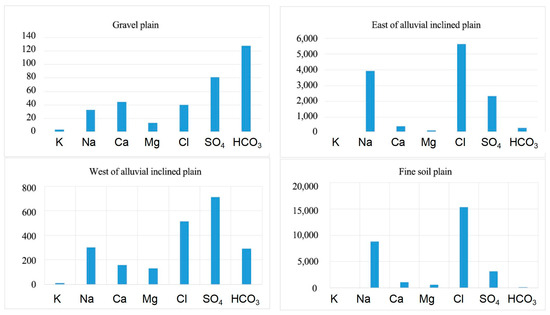
Figure 3.
Relationship of average ion concentration in groundwater at different locations (mg/L).
3.2. Spatial Distribution Characteristics of Water Chemistry
The distribution of hydrochemical types in the Piper diagram helps to explain the evolution of groundwater hydrochemistry along the flow path []. The Durov diagram also shows the salinity and pH of different water chemical types []. The chemical types of groundwater are mainly HCO3·SO4-Ca·Na, SO4·Cl-Na·Ca, Cl·SO4-Na, and Cl-Na types in the study area, which demonstrate the characteristics of multi-type water chemistry (Figure 4).
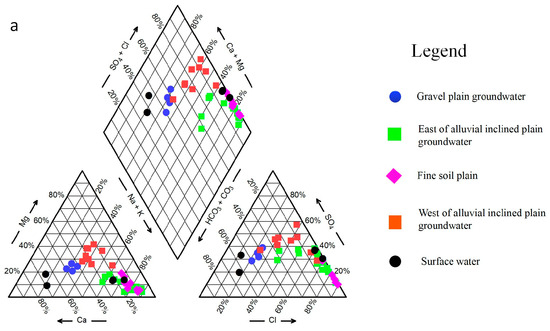
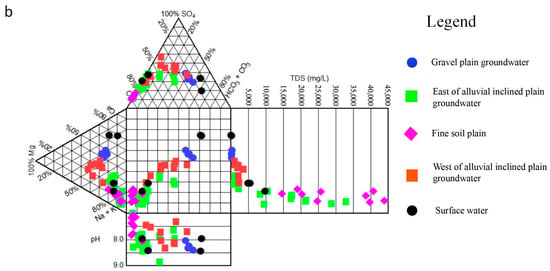
Figure 4.
(a)—Piper diagram of groundwater and surface water from various sources in the study area; (b)—Durov diagram of groundwater and surface water from various sources in the study area.
The surface water and groundwater of the gravel plain are the HCO3·SO4-Ca·Na type, and the salinity mass concentration is less than 1000 mg/L, reflecting the low content of the total dissolved solids in the recharge area. From the gravel plain to the inclined plain, due to the finer aquifer particles and weaker water permeability, the chemical types of groundwater in the deep water evolved into saltier SO4·Cl-Na·Ca and Cl·SO4-Na types with a mass concentration of mineralization greater than 1000 mg/L. At the end of the inclined plain on the east side, the maximum salinity mass concentration can reach 10,000 mg/L, and the chemical type of groundwater gradually changes to the Cl-Na type. It is worth noting that the overall salinity mass concentration of the inclined plain on the west side is lower than that on the east side. These findings reveal that the groundwater on the west side is buried deeper; its runoff rate is fast; and it does not easily evaporate, concentrate, or dissolve. In the fine soil plain, the mass concentration of salinity increased and was recorded as greater than 20,000 mg/L. Cl− and Na+ were the dominant ions, and the chemical type of groundwater was characterized as the Cl-Na type. This reflects the chemical characteristics of groundwater with high salinity in the discharge area.
3.3. Hydrochemical Origin Analysis
3.3.1. Genetic Mechanism of Groundwater
A Gibbs diagram was used to explain the genetic mechanism of the chemical components of water. In the Gibbs diagram, if the TDS value is high and the Na+/(Na+ + Ca2+) or Cl−/(Cl− + HCO3−) ratio is also high (close to 1), the ion control mechanism is evaporation crystallization; if the TDS value is moderate and the ratio of Na+/(Na+ + Ca2+) or Cl−/(Cl− + HCO3−) is less than 0.5, the ion control mechanism is the water–rock interaction; and if the TDS value is low and the Na+/(Na+ + Ca2+) or Cl−/(Cl− + HCO3−) ratio is close to 1, the hydrochemical component control mechanism is atmospheric precipitation [].
The chemical composition of groundwater in the study area is mainly dominated by the water–rock process and the evaporation crystallization process (Figure 5). Specifically, the chemical composition of groundwater in the gravel plain is dominated by water–rock interactions. The chemical composition of groundwater in the inclined plain is controlled by both water–rock and evaporation–crystallization processes. The groundwater in the fine soil plain is distributed in the evaporative crystallization domain, and some minerals may have reached supersaturation and precipitated out. Moreover, the groundwater level is shallow, and the influence of evaporation and concentration is strong. Therefore, the groundwater chemistry in this region is mainly controlled by evaporation and crystallization.
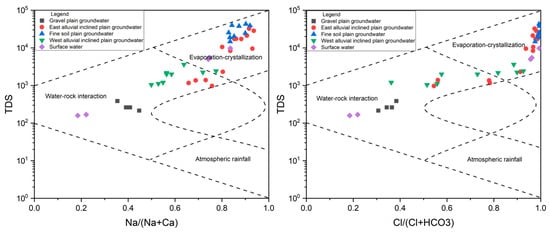
Figure 5.
The Gibbs diagram of groundwater and surface water.
3.3.2. Major Ion Proportional Relationship
In the process of groundwater circulation, the proportion coefficient between the contents of each component has obvious regularity, which can describe the chemical origin and formation process of groundwater more deeply [,]. Figure 6 shows the correlation of major ions in groundwater in the study area. It can be seen from Figure 6a that the groundwater sample points are mostly distributed along the Na+/Cl− ratio line (halite dissolution line), and the content of Na+ at the groundwater sample points in the gravel plain and most of the eastern inclined plain is slightly higher than that of Cl−. This indicates that there are other sources of Na+ in groundwater besides the dissolution of halite; for example, aluminosilicate minerals such as albite also affect the Na+ concentration (Formula (3)). The excess Na+ may also come from cation exchange in aquifers (Formula (1)). The content of Na+ in groundwater samples of the fine soil plain and some inclined plains in the west is slightly lower than that of Cl−, which may be the result of cation exchange in the aquifers (Formula (2)).
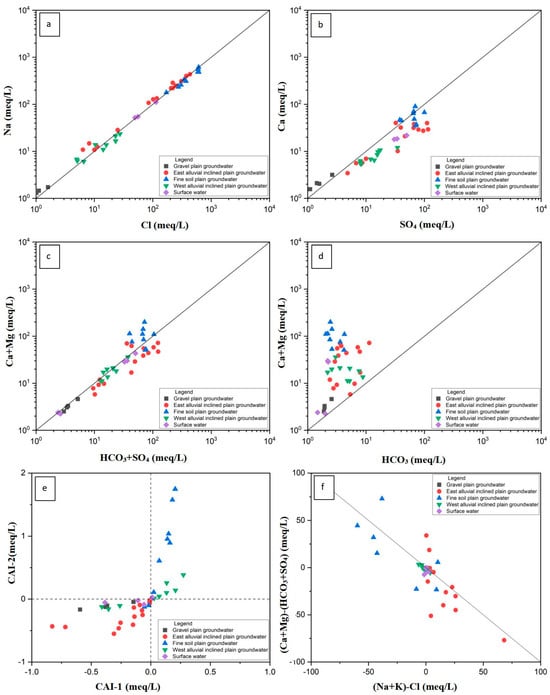
Figure 6.
Major ion proportional relationship. Note: (a): ratio of ion concentration of sodium to chloride; (b): ratio of ion concentration of calcium to sulfate; (c): ratio of calcium and magnesium ion concentrations to bicarbonate and sulfate; (d): The ratio of calcium and magnesium ion concentrations to bicarbonate; (e): the ratio of chlor-alkali index 2 to chlor-alkali index 1; (f): the ratio of ion concentrations of calcium and magnesium minus bicarbonate and sulfate to sodium and potassium minus chlorine.
The relationship between Ca2+ and SO42− in water samples from the study area shows a linear change (Figure 6b), indicating that gypsum dissolution is the main source of Ca2+ and SO42− in groundwater. Incline plain groundwater samples deviate downward from the Ca2+/SO42− to a 1:1 line, indicating SO42− enrichment or Ca2+ depletion, which may be the result of cation exchange (Formula (2)) or carbonate precipitation reducing Ca2+ content in the groundwater. It can be observed from the relationship between (Ca2+ + Mg2+) and (HCO3− + SO42−) that groundwater samples from the gravel plain and the east-inclined plain are distributed along the 1:1 line (Figure 6c), indicating that the dissolution of calcite, dolomite, and gypsum is a potential source of major ions in the process of groundwater mineralization. The water samples of the east-inclined plain are mostly below 1:1, indicating that (Ca2+ + Mg2+) may decrease with cation exchange (Formula (2)).
Ca2+ or Mg2+ + 2NaX→2Na+ + CaX2 or MgX2
2Na+ + CaX2 or MgX2→Ca2 + or Mg2+ + 2NaX
NaAlSi3O8 + 8H2O→Na+ + Al(OH)4− + 3H4SiO4
Most of the water sample points in the fine soil plain are above the 1:1 line, indicating that (Ca2+ + Mg2+) may increase with cation exchange (Equation (1)). As shown in Figure 6d, most sample points deviate upward from the (Ca2+ + Mg2+)/HCO3− to the 1:1 line, indicating that Ca2+ and Mg2+ in groundwater not only come from dolomite and calcite but also from other sources, such as gypsum dissolution.
Chloro-alkaline index indices (CAIs) are usually used to characterize the intensity of ion exchange during the chemical evolution of groundwater. If CAI-1 and CAI-2 are both less than 0, positive ion exchange occurs (Formula (4)), and the Ca2+ or Mg2+ in the groundwater displaces the Na+ in aquifer minerals; if CAI-1 and CAI-2 are greater than 0, negative ion exchange occurs (Formula (5)), and Na+ in the groundwater displaces the Ca2+ or Mg2+ in the aquifer minerals []. In addition, the greater the absolute value of the chlor-alkali index, the higher the degree of ion exchange [].
Negative cation exchange occurs in most of the groundwater in the fine soil plain and the west-inclined plain. In addition, positive cation exchange occurs in the groundwater in the fine soil plain, which is consistent with the above description. In addition, the relationship of [(Na+ + K+)-Cl−] and [(Ca2+ + Mg2+)-(HCO3− + SO42−)] can also be used to represent cation exchange (Figure 6e). [(Na+ + K+)-Cl−] represents the increase or decrease in (Na+ + K+) except for the dissolution of halite. [(Ca2+ + Mg2+)-(HCO3− + SO42−)] represents the increase or decrease in (Ca2+ + Mg2+) in addition to the dissolution of calcite, dolomite, and gypsum []. If the linear relationship between the two is −1, cation exchange occurs. Most of the groundwater samples are distributed near the slope of −1 and along the right side; this shows that there is more Na+ and less Ca2+ + Mg2+ in the groundwater, indicating that positive cation exchange occurs widely in the study area. There is more Ca2+ + Mg2+ and less Na+ in the groundwater of some fine soil plain and inclined-plain areas on the west side; this indicates that negative cation exchange occurs, which is consistent with the conclusion of the chlor-alkali index (Figure 6f).
3.4. Hydrogeochemical Simulation Analysis
PhreeqC can be used to calculate the saturation index of the main minerals in groundwater; judge the dissolution state of halite, gypsum, calcite, dolomite, and other minerals in groundwater; and carry out a reverse hydrogeochemical simulation to further determine the actual contribution of each major mineral in the groundwater evolution process. The PhreeqC version used in this study was 3.7.3, and the thermodynamic database was LLNL.
3.4.1. Mineral Saturation Index
The saturation index of minerals can intuitively show the dissolution equilibrium state of a certain component in groundwater. Figure 6 shows the saturation index relationship of major minerals such as halite, gypsum, calcite, and dolomite in the groundwater of the study area. When SI > 0, it indicates that the mineral phase is in a supersaturated state. When SI = 0, it means that the mineral phase is in equilibrium. SI < 0 indicates that the mineral phase is in a dissolved state.
The data in Table 2 reveal that halite and gypsum are mostly found in an unsaturated state from the gravel plain to the fine soil plain, while only a small part of the fine soil plain is in a saturated state, indicating that the dissolution of halite and gypsum is a major source of Na+, Cl−, Ca2+, and SO42− in the process of groundwater mineralization in the study area. The majority of the calcite and dolomite saturation indices are positive, and the calcite and dolomite in the groundwater are either saturated or over-saturated in most areas. This suggests that the dissolution of calcite and dolomite minerals is not the main source of Ca2+, Mg2+, and HCO3− in the process of groundwater mineralization (Figure 7).

Table 2.
List of saturation indices of major minerals in the study area.
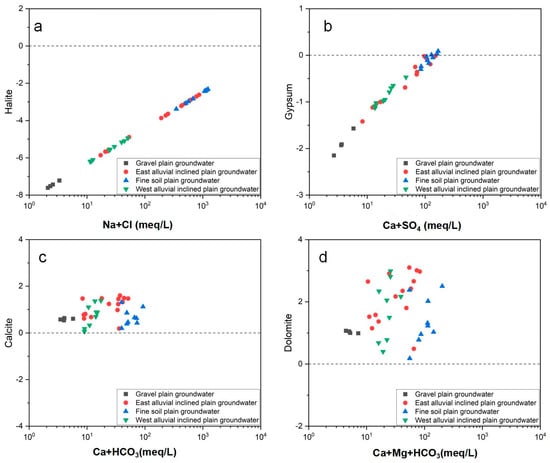
Figure 7.
Plots of saturation index vs. ion concentration for the major minerals and ions in the groundwater in the study area. Note: dashed lines represent zero values; (a): the saturation of Halite is related to sodium and potassium concentrations; (b): The saturation of gypsum is related to the concentration of calcium and sulfate; (c): the saturation of calcite is related to the concentration of calcium and bicarbonate; (d): The saturation of dolomite is related to the concentration of calcium, magnesium and bicarbonate.
3.4.2. Reverse Hydrogeochemical Modeling
Some researchers have used PhreeqC for species saturation calculations and EQ3/6 visualization package 8.0a to model rock dissolution reaction pathways [,]. Reverse hydrogeochemical simulation uses the material balance model to estimate the amount of mineral precipitation or dissolution between two different points on the groundwater flow path [] and explains the formation and evolution of hydrochemical composition through the identification and quantitative hydrogeochemical reaction of water and rock [].
In this study, to further verify the hydrogeochemical process from the recharge area to the discharge area, a simulation path was selected based on the hydrogeological data of the study area and the existing hydrochemical analysis results, and PhreeqC was used to conduct a reverse hydrogeochemical simulation to quantitatively represent the water–rock interaction process. According to previous data and the groundwater level map (Figure 1), the general runoff direction of groundwater is from northwest to southeast, from gravel plain to fine soil plain, and combined with the evolution of water chemical types, a simulated path covering recharge–runoff–discharge is determined: G2–G25–G51 (Figure 2b).
The selection of possible mineral phases is a key step in the success of reverse hydrogeochemical simulation, which is mainly based on hydrochemical analysis, rock mineral identification, and characteristics of water-bearing media []. According to the above hydrochemical analysis, the main mineral phases in the study area are calcite, dolomite, halite, and gypsum. In the process of hydrochemical evolution, cation exchange is essential and should be regarded as a mineral phase. Considering that CO2(g) is continuously dissolved into groundwater, CO2(g) should also be considered as a possible mineral phase. In hydrochemical analysis, the dissolution of albite and anorthite will affect Na+ and Ca2+ and should be considered as a possible mineral phase. According to the results of water chemistry determination, Na, Ca, Mg, C, S, and Cl were set as constraint variables.
The simulation results shown in Table 3 were analyzed as follows:

Table 3.
The results of the reverse hydrogeochemical simulation.
- (1)
- G2–G25: Along the runoff from the gravel plain to the inclined plain, the main water–rock process that caused the change in groundwater chemical composition was calcite, with a precipitation of 1.31 × 10−2 mmol/L. The dissolution amounts of halite, gypsum, and calcite were 4.18 × 10−2, 8.36 × 10−2, and 6.60 × 10−3 mmol/L, respectively. The positive cation exchange results were 1.69 × 10−2 mmol/L Ca2+ leaving groundwater and 3.37 × 10−2 mmol/L Na+ entering groundwater. The dissolved amount of CO2 was 9.61 × 10−5 mmol/L due to the precipitation of carbonate and the dissolved amount of halite and sulfate gypsum. At the same time, under the influence of positive cation exchange, Na+, Cl−, and SO42− were increased, and the hydrochemical type evolved from the HCO3·SO4-Ca-·Na type to the SO4·Cl-Na·Ca. Cl·SO4-Na type.
- (2)
- G25–G51: Along the runoff from the inclined plain to the fine soil plain, the following water–rock interactions mainly occurred between the two points: the precipitation of calcite occurred, and the precipitation amount was 1.32 × 10−1 mmol/L; dolomite, halite, and gypsum were dissolved in 6.58 × 10−2, 1.89 × 10−1, and 2.38 × 10−2 mmol/L, respectively. The negative cation exchange results were 9.45 × 10−2 mmol/L Ca2+ entering groundwater and −1.89 × 10−1 mmol/L Na+ leaving groundwater. Because both halite and gypsum are continuously dissolving, and halite has a higher dissolution capacity than gypsum, the TDS level rose as the amount of Na+ and Cl- in the groundwater increased. With this, the hydrochemical type changed from the Cl·SO4-Na type to the Cl-Na type.
It should be noted that the dissolution of dolomite is inconsistent with the above conclusion that the saturation index is in a saturated state, which may be caused by the groundwater dissolving CO2 in the runoff process, making it continue dissolving dolomite and lagging precipitation [,,,].
4. Conclusions
Using traditional hydrochemical research methods and hydrogeochemical simulation, this study analyzed the hydrogeochemical evolution process of groundwater from gravel plain to fine soil plain in the Tailan River Basin. Based on the results of this study, the following conclusions were made:
- (1)
- The chemical types of groundwater in the study area have obvious zonation, which reflects the evolution of groundwater recharge, runoff, and discharge in arid inland basins. From the gravel plain to the fine soil plain, in the direction of runoff, the chemical type of groundwater changed from the HCO3·SO4-Ca Na type of fresh water to the SO4·Cl-Na·Ca, Cl· SO4-Na, and Cl-Na types of salt water. The medium particles of the aquifer in the gravel plain and inclined plain were relatively coarse, and the groundwater regeneration and alternations were relatively fast. In these plains, water–rock interaction and mainly positive cation exchange processes controlled hydrochemical components. The medium particles of the aquifer in the fine soil plain were relatively fine; the regeneration and alternation rate of groundwater was relatively slow; and the hydrochemical components were mainly affected by evaporation, concentration, and, more significantly, negative cation exchange.
- (2)
- The relationship between ion ratio and saturation index showed that the ion components of groundwater mineralization are mainly released from the dissolution of halite and gypsum, the precipitation of dolomite and calcite, and positive and negative cation exchange.
- (3)
- Based on the reverse hydrogeochemical simulation, the main water–rock interactions of groundwater in the direction of the runoff were the dissolution of halite and gypsum, precipitation of calcite and dolomite, cation exchange, and dissolution of carbon dioxide. In particular, the dissolution of halite and gypsum and positive cation exchange are the main interactions from the gravel plain to the inclined plain. The fine soil plain is dominated by negative cation exchange, and the simulation results quantitatively validated the results of qualitative analysis on the main water–rock interaction.
This study will deepen researchers’ understandings of the groundwater cycle and hydrochemical evolution of the Tailan River. The research data obtained can be used as a reference for understanding the groundwater cycle and hydrogeochemical evolution of intermountain basins in other similar arid areas.
Author Contributions
Conceptualization, methodology, data analysis, data collection, and writing original draft, L.L.; Conceptualization, Y.L. and L.Y.; software, J.B.; formal analysis, L.C.; investigation, Z.Y. All authors have read and agreed to the published version of the manuscript.
Funding
This paper was supported by the Kekeya Project of the Urumqi Comprehensive Survey Center on Natural Resources, China Geological Survey (Project number: ZD20220232).
Data Availability Statement
The data presented in this study are available in article.
Acknowledgments
The authors are very grateful to tutors Lu Yudong and Yin Lihe for their guidance and Cui Liyang and Yang Zhi for their help. The authors would also like to express sincere thanks to the editors and reviewers for their contributions to the manuscript.
Conflicts of Interest
The authors declare no conflict of interest.
References
- Xiaomin, G.; Qiulan, Z.; Yali, C.; Jingli, S.; Yong, X.; Peng, Z.; Jinxing, L. Hydrogeochemistry and Genesis Analysis of Thermal and Mineral Springs in Arxan, Northeastern China. Water 2017, 9, 61. [Google Scholar]
- Aher, K.R.; Pathrikar, P.B.; Golekar, R.B.; Gaikwad, G.D.; Borgawkar, A.R.; Kathane, P.V. Application of Water Quality Index and Multivariate Statistical Analysis in the Hydrogeochemical Assessment of Shallow Groundwater in Part of Purna Basin, Maharashtra, India. Bull. Pure Appl. Sci. Sect. F Geol. Int. Res. J. Geol. Sci. 2020, 39F, 239–255. [Google Scholar] [CrossRef]
- Xiao, Y.; Shao, J.; Cui, Y.; Zhang, G.; Zhang, Q. Groundwater circulation and hydrogeochemical evolution in Nomhon of Qaidam Basin, northwest China. J. Earth Syst. Sci. 2017, 126, 26. [Google Scholar] [CrossRef]
- Zhang, Z.; Wang, Z.; Xu, Y.; Zhang, Y.; Tang, L. Quantitative Study on the Changes of Karst Groundwater Level and Hydrochemistry in Jinci Spring Catchment, Shanxi, China. Expo. Health 2020, 12, 513–525. [Google Scholar] [CrossRef]
- Zheng, Q.; Li, Y.; Zhang, Y.; Zhang, Z.; Wu, A.; Shi, H. Adsorption of sulfate from acid mine drainage in Northwestern China using Malan loess. Arab. J. Geosci. 2019, 12, 348. [Google Scholar] [CrossRef]
- Gui-Zhi, W.; De-Shan, T. Application of Improved GM(1,1) Model in Predicting of Water Diversion of Tai lan River Irrigation Area. Water Conserv. Sci. Technol. Econ. 2012, 18, 28–30. [Google Scholar]
- Bo, C. Research on Groundwater Resource Management in Aksu City. Energy Energy Conserv. 2017, 12, 93–94. [Google Scholar]
- Li, Q.; Jia, R.; Zhou, J. Chemical characteristics of high fluoride groundwater in Aksu Area, Xinjiang. J. Arid. Land Resour. Environ. 2013, 27, 87–92. [Google Scholar]
- Bai, C. Distribution and Water Quality Evaluation of Middle-Salinity Groundwater in Tarim Basin; Xinjiang Agricultural University: Urumqi, China, 2013. [Google Scholar]
- Xu, D. Study on the Characteristics and Controlling Factors of Groundwater Chemical Evolution in Suxian Mining Area; Hefei University of Technology: Hefei, China, 2017. [Google Scholar]
- Barbecot, F.; Marlin, C.; Gibert, E.; Dever, L. Hydrochemical and isotopic characterisation of the Bathonian and Bajocian coastal aquifer of the Caen area (Northern France). Appl. Geochem. 2000, 15, 791–805. [Google Scholar] [CrossRef]
- Sikdar, P.K.; Sarkar, S.S.; Palchoudhury, S. Geochemical evolution of groundwater in the Quaternary aquifer of Calcutta and Howrah, India. J. Asian Earth Sci. 2001, 19, 579–594. [Google Scholar] [CrossRef]
- Yang, M.; Lu, Y.; Zhang, F.; Zhang, S.; Yin, M.; Wu, G. Chemical evolution and geochemical simulation of karst water in Liulin Spring Basin. South–North Water Divers. Water Sci. Technol. 2018, 16, 127–134. [Google Scholar]
- Jiangtao, Z.; Jinlong, Z.; Chuan, L.; Zhong, Y.; Li, Q.; Zhengde, B. Reverse hydrogeochemical simulation of groundwater in the plain area of Yanqi Basin, Xinjiang. J. Arid. Land Resour. Environ. 2017, 31, 65–70. [Google Scholar]
- Wei, X.; Zhou, J.L.; Nai, W.H.; Zeng, Y.Y.; Fan, W.; Li, B. Chemical characteristics and evolution of groundwater in Kashi Delta, Xinjiang. Environ. Sci. 2019, 40, 4042–4051. [Google Scholar]
- Wu, Q.; Liang, Y.; Gao, F.; Du, M.; Wu, B.; Liu, J. Water chemical characteristics, distribution and origin analysis of brackish water in Alar City, Xinjiang. Arid. Land Geogr. 2021, 40, 737–745. [Google Scholar]
- Ding, Q.; Zhou, J.; Zeng, Y.; Lei, M.; Sun, Y. Analysis of groundwater hydrochemistry and its influencing factors based on multivariate statistical method in Barkol Basin, Xinjiang. Water Resour. Water Eng. 2011, 32, 78–83. [Google Scholar]
- Li, L. The transformation relationship between surface water and groundwater in Tarim River Basin. Soil Water Conserv. 2011, 41, 23–28. [Google Scholar] [CrossRef]
- Remi, Z.J.; Fan, W.; Zhang, J. Characteristics of groundwater chemical evolution in Aksu Plain, Xinjiang. Geol. Environ. 2020, 48, 602–611. [Google Scholar]
- Karunanidhi, D.; Subramani, T.; Roy, P.D.; Li, H. Impact of groundwater contamination on human health. Environ. Geochem. Health 2021, 43, 643–647. [Google Scholar] [CrossRef] [PubMed]
- Barzegar, R.; Moghaddam, A.A.; Adamowski, J.; Nazemi, A.H. Assessing the potential origins and human health risks of trace elements in groundwater: A case study in the Khoy plain, Iran. Environ. Geochem. Health 2019, 41, 981–1002. [Google Scholar] [CrossRef] [PubMed]
- Huh, Y.; Tsoi, M.Y.; Zaitsev, A.; Edmond, J.M. The fluvial geochemistry of the rivers of Eastern Siberia: I. Tributaries of the Lena River draining the sedimentary platform of the Siberian Craton. Geochim. Cosmochim. Acta 1998, 62, 1657–1676. [Google Scholar] [CrossRef]
- GB 8537-2018; National Food Safety Standard: Drinking Natural Mineral Water. National Health and Wellness Commission: Beijing, China, 2018.
- WHO. Guidelines for Drinking-Water Quality, 4th ed.; incorporating the 1st addendum; WHO: Geneva, Switzerland, 2017. [Google Scholar]
- Wang, J.; Liang, X.; Liu, Y.; Jin, M.; Knappett, P.S.K.; Liu, Y. Hydrogeochemical Evolution Along Groundwater Flow Paths in the Manas River Basin, Northwest China. Ground Water 2019, 57, 575–589. [Google Scholar] [CrossRef] [PubMed]
- Procesi, M.; Marini, L.; Cinti, D.; Sciarra, A.; Basile, P.; Mazzoni, T.; Zarlenga, F. Preliminary fluid geochemical survey in Tete Province and prospective development of geothermics in Mozambique. Geotherm. Energy 2022, 10, 2. [Google Scholar] [CrossRef]
- Huihui, D.; Jun, D.; Ning, Y.; Yang, D.; Ying, G.; Guoxiao, W.; University, L. Study of the evolution of hydrochemical properties of groundwater in Ulan Buh Desert in the north of the Helan Mountains. J. Glaciol. Geocryol. 2015, 37, 793–802. [Google Scholar]
- Xing, L.; Guo, H.; Zhan, Y. Groundwater hydrochemical characteristics and processes along flow paths in the North China Plain. J. Asian Earth Sci. 2013, 70, 250–264. [Google Scholar] [CrossRef]
- Zhu, B.; Yang, X.; Rioual, P.; Qin, X.; Liu, Z.; Xiong, H.; Yu, J. Hydrogeochemistry of three watersheds (the Erlqis, Zhungarer and Yili) in northern Xinjiang, NW China. Appl. Geochem. 2011, 26, 1535–1548. [Google Scholar] [CrossRef]
- Wang, H.; Jiang, X.W.; Wan, L.; Han, G.; Guo, H. Hydrogeochemical characterization of groundwater flow systems in the discharge area of a river basin. J. Hydrol. 2015, 527, 433–441. [Google Scholar] [CrossRef]
- Schoeller, H. Qualitative evaluation of groundwater resources. Methods Tech. Groundw. Investig. Dev. 1967, 33, 54–83. [Google Scholar]
- Helstrup, T.; Jrgensen, N.O.; Banoeng-Yakubo, B. Investigation of hydrochemical characteristics of groundwater from the Cretaceous-Eocene limestone aquifer in southern Ghana and southern Togo using hierarchical cluster analysis. Hydrogeol. J. 2007, 15, 977–989. [Google Scholar] [CrossRef]
- Apollaro, C.; Fuoco, I.; Gennaro, E.; Giuliani, L.; Iezzi, G.; Marini, L.; Radica, F.; Di Luccio, F.; Ventura, G.; Vespasiano, G. Advanced argillic alteration at Cave di Caolino, Lipari, Aeolian Islands (Italy): Implications for the mitigation of volcanic risks and the exploitation of geothermal resources. Sci. Total Environ. 2023, 889, 164333. [Google Scholar] [CrossRef]
- Apollaro, C.; Marini, L.; Rosa, R.D. Use of reaction path modeling to predict the chemistry of stream water and groundwater: A case study from the Fiume Grande valley (Calabria, Italy). Environ. Geol. 2007, 51, 1133–1145. [Google Scholar] [CrossRef]
- Lu, X.; Sun, J.; Liu, J.; Jin, S.; Liu, J. Groundwater evolution and geochemical simulation in Sandan water source. Yellow River 2014, 36, 84–88. [Google Scholar]
- Soumya, B.S.; Sekhar, M.; Riotte, J.; Audry, S.; Lagane, C.; Braun, J.J. Inverse models to analyze the spatiotemporal variations of chemical weathering fluxes in a granito-gneissic watershed: Mule Hole, South India. Geoderma 2011, 165, 12–24. [Google Scholar] [CrossRef]
- Yang, N.; Wang, G.; Shi, Z.; Zhao, D.; Jiang, W.; Guo, L.; Liao, F.; Zhou, P. Application of Multiple Approaches to Investigate the Hydrochemistry Evolution of Groundwater in an Arid Region: Nomhon, Northwestern China. Water 2018, 10, 1667. [Google Scholar] [CrossRef]
- Mayo, A.L.; Loucks, M.D. Solute and isotopic geochemistry and ground water flow in the central Wasatch Range, Utah. J. Hydrol. 1995, 172, 31–59. [Google Scholar] [CrossRef]
- Wanjun, J.; Dan, Z.; Guangcai, W.; Yonghai, G.; Chenglong, L.; Tao, Z.; Shufen, L.; Chenzhi, H.E. Hydro-geochemical Characteristics and Formation of Groundwater in Tu-Ha Basin, Xinjiang. Geoscience 2016, 30, 825–833. [Google Scholar]
- Wang, J. Numerical Simulation of Groundwater Flow Models and Typical Systems in Arid Inland Basins; China University of Geosciences: Wuhan, China, 2020. [Google Scholar]
- Xu, Y. Study on Groundwater Chemical Evolution and Water Cycle Characteristics in the Western Plain Area of Yili Valley, Xinjiang; North China University of Water Resources and Electric Power: Zhengzhou, China, 2020. [Google Scholar]
Disclaimer/Publisher’s Note: The statements, opinions and data contained in all publications are solely those of the individual author(s) and contributor(s) and not of MDPI and/or the editor(s). MDPI and/or the editor(s) disclaim responsibility for any injury to people or property resulting from any ideas, methods, instructions or products referred to in the content. |
© 2023 by the authors. Licensee MDPI, Basel, Switzerland. This article is an open access article distributed under the terms and conditions of the Creative Commons Attribution (CC BY) license (https://creativecommons.org/licenses/by/4.0/).